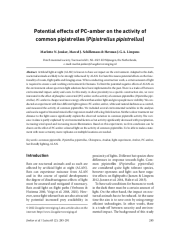Potential effects of PC-amber on the activity of common pipistrelles (Pipistrellus pipistrellus)

Authors: Marlotte N. Jonker, Marcel J. Schillemans & Herman J.G.A. Limpens
Abstract: Artificial light at night (ALAN) is known to have an impact on the environment. Adapted to the dark, nocturnal animals are likely to be strongly influenced by ALAN. For bats this means potential effects on the functionality of roosts, flight paths and foraging areas. When conducting construction work, a certain amount of light is required to ensure a safe working environment for humans. To limit the potential negative effects of ALAN on the environment colour spectrum light solutions have been implemented in the past. There is a trade-off between environmental impact, safety and costs. In this study, in close proximity to a specific construction site, we were interested in the effect of phosphor converted (PC) amber on the activity of common pipistrelles (Pipistrellus pipistrellus). PC-amber is cheaper and more energy-efficient than amber light and gives people more visibility. We conducted an experiment with four different light regimes: PC-amber, amber, white and natural darkness as a control, and measured the activity of common pipistrelles. We included several environmental variables in the analyses and used a negative binomial mixed-effect regression model with a log-link function. Neither colour treatment nor distance to the light source significantly explain the observed variation in common pipistrelle activity. The variance in data is partly explained by environmental factors as bat activity significantly decreased with precipitation, increasing wind speed and increasing moon illumination. Based on this experiment, no firm conclusion can be drawn on the effect of PC-amber coloured light on the activity of common pipistrelles. To be able to make a statement with more certainty, more replicates on multiple locations are needed.
